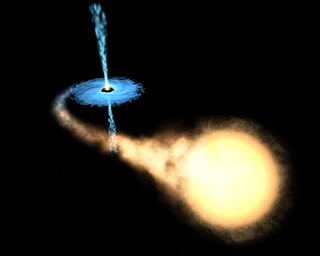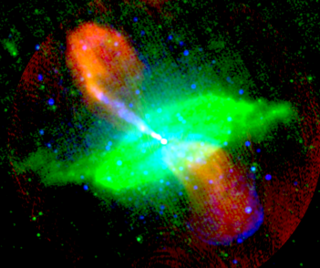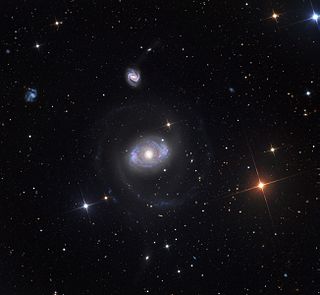Related Research Articles
Timeline of black hole physics
An active galactic nucleus (AGN) is a compact region at the center of a galaxy that has a much-higher-than-normal luminosity over at least some portion of the electromagnetic spectrum with characteristics indicating that the luminosity is not produced by stars. Such excess non-stellar emission has been observed in the radio, microwave, infrared, optical, ultra-violet, X-ray and gamma ray wavebands. A galaxy hosting an AGN is called an "active galaxy". The non-stellar radiation from an AGN is theorized to result from the accretion of matter by a supermassive black hole at the center of its host galaxy.

X-ray binaries are a class of binary stars that are luminous in X-rays. The X-rays are produced by matter falling from one component, called the donor, to the other component, called the accretor, which is very compact: a neutron star or black hole. The infalling matter releases gravitational potential energy, up to several tenths of its rest mass, as X-rays. The lifetime and the mass-transfer rate in an X-ray binary depends on the evolutionary status of the donor star, the mass ratio between the stellar components, and their orbital separation.

A radio galaxy is a galaxy with giant regions of radio emission extending well beyond its visible structure. These energetic radio lobes are powered by jets from its active galactic nucleus. They have luminousities at radio wavelengths up to 1039 W between 10 MHz and 100 GHz. The radio emission is due to the synchrotron process. The observed structure in radio emission is determined by the interaction between twin jets and the external medium, modified by the effects of relativistic beaming. The host galaxies are almost exclusively large elliptical galaxies. Radio-loud active galaxies can be detected at large distances, making them valuable tools for observational cosmology. Recently, much work has been done on the effects of these objects on the intergalactic medium, particularly in galaxy groups and clusters.

A supermassive black hole is a type of black hole, with its mass being on the order of millions to billions of times the mass of the Sun (M☉). Black holes are a class of astronomical objects that have undergone gravitational collapse, leaving behind spheroidal regions of space from which nothing can escape, not even light. Observational evidence indicates that almost every large galaxy has a supermassive black hole at its center. For example, the Milky Way has a supermassive black hole in its Galactic Center, corresponding to the radio source Sagittarius A*. Accretion of interstellar gas onto supermassive black holes is the process responsible for powering active galactic nuclei and quasars.

A blazar is an active galactic nucleus (AGN) with a relativistic jet directed very nearly towards an observer. Relativistic beaming of electromagnetic radiation from the jet makes blazars appear much brighter than they would be if the jet were pointed in a direction away from Earth. Blazars are powerful sources of emission across the electromagnetic spectrum and are observed to be sources of high-energy gamma ray photons. Blazars are highly variable sources, often undergoing rapid and dramatic fluctuations in brightness on short timescales. Some blazar jets exhibit apparent superluminal motion, another consequence of material in the jet traveling toward the observer at nearly the speed of light.

An astrophysical jet is an astronomical phenomenon where outflows of ionised matter are emitted as an extended beam along the axis of rotation. When this greatly accelerated matter in the beam approaches the speed of light, astrophysical jets become relativistic jets as they show effects from special relativity.

NGC 5548 is a Type I Seyfert galaxy with a bright, active nucleus. This activity is caused by matter flowing onto a 65 million solar mass (M☉) supermassive black hole at the core. Morphologically, this is an unbarred lenticular galaxy with tightly-wound spiral arms, while shell and tidal tail features suggest that it has undergone a cosmologically-recent merger or interaction event. NGC 5548 is approximately 245 million light years away and appears in the constellation Boötes. The apparent visual magnitude of NGC 5548 is approximately 13.3 in the V band.

OJ 287 is a BL Lac object 3.5 billion light-years from Earth that has produced quasi-periodic optical outbursts going back approximately 120 years, as first apparent on photographic plates from 1891. Seen on photographic plates since at least 1887, it was first detected at radio wavelengths during the course of the Ohio Sky Survey. It is a supermassive black hole binary. The intrinsic brightness of the flashes corresponds to over a trillion times the Sun's luminosity, greater than the entire Milky Way galaxy's light output.

NGC 4151 is an intermediate spiral Seyfert galaxy with weak inner ring structure located 15.8 megaparsecs from Earth in the constellation Canes Venatici. The galaxy was first mentioned by William Herschel on March 17, 1787; it was one of the six Seyfert galaxies described in the paper which defined the term. It is one of the nearest galaxies to Earth to contain an actively growing supermassive black hole. The black hole would have a mass on the order of 2.5 million to 30 million solar masses. It was speculated that the nucleus may host a binary black hole, with about 40 million and about 10 million solar masses respectively, orbiting with a 15.8-year period. This is, however, still a matter of active debate.

Gamma-ray burst progenitors are the types of celestial objects that can emit gamma-ray bursts (GRBs). GRBs show an extraordinary degree of diversity. They can last anywhere from a fraction of a second to many minutes. Bursts could have a single profile or oscillate wildly up and down in intensity, and their spectra are highly variable unlike other objects in space. The near complete lack of observational constraint led to a profusion of theories, including evaporating black holes, magnetic flares on white dwarfs, accretion of matter onto neutron stars, antimatter accretion, supernovae, hypernovae, and rapid extraction of rotational energy from supermassive black holes, among others.
Ursa Major B or 3C 244.1 is a radio galaxy located in the constellation Ursa Major.

A black hole spin-flip occurs when the spin axis of a rotating black hole undergoes a sudden change in orientation due to absorption of a second (smaller) black hole. Spin-flips are believed to be a consequence of galaxy mergers, when two supermassive black holes form a bound pair at the center of the merged galaxy and coalesce after emitting gravitational waves. Spin-flips are significant astrophysically since a number of physical processes are associated with black hole spins; for instance, jets in active galaxies are believed to be launched parallel to the spin axes of supermassive black holes. A change in the rotation axis of a black hole due to a spin-flip would therefore result in a change in the direction of the jet.

Astrophysical X-ray sources are astronomical objects with physical properties which result in the emission of X-rays.

An accretion disk is a structure formed by diffuse material in orbital motion around a massive central body. The central body is typically a star. Friction, uneven irradiance, magnetohydrodynamic effects, and other forces induce instabilities causing orbiting material in the disk to spiral inward towards the central body. Gravitational and frictional forces compress and raise the temperature of the material, causing the emission of electromagnetic radiation. The frequency range of that radiation depends on the central object's mass. Accretion disks of young stars and protostars radiate in the infrared; those around neutron stars and black holes in the X-ray part of the spectrum. The study of oscillation modes in accretion disks is referred to as diskoseismology.

NGC 2768 is a lenticular galaxy located in the constellation of Ursa Major. It is at a distance of 65 million light years from Earth. NGC 2768 is an example of a Seyfert galaxy, an object with a supermassive black hole at its centre. A dusty structure is encircling the centre of the galaxy, forming a knotted ring around the galaxy's brightly glowing middle. This ring lies perpendicular to the plane of NGC 2768 itself, stretching up and out of the galaxy. The dust in NGC 2768 forms an intricate network of knots and filaments.

NGC 326 is a dumbbell galaxy in the constellation Pisces. It was discovered on August 24, 1865 by Heinrich d'Arrest. It was described by Dreyer as "faint, a little extended, 9th or 10th magnitude star to southeast."

NGC 708 is an elliptical galaxy located 240 million light-years away in the constellation Andromeda and was discovered by astronomer William Herschel on September 21, 1786. It is classified as a cD galaxy and is the brightest member of Abell 262. NGC 708 is a weak FR I radio galaxy and is also classified as a type 2 Seyfert galaxy.

Johann Anton Zensus is a German radio astronomer. He is director at the Max Planck Institute for Radio Astronomy (MPIfR) and honorary professor at the University of Cologne. He is chairman of the collaboration board of the Event Horizon Telescope (EHT). The collaboration announced the first image of a black hole in April 2019.

NGC 3998 is a lenticular galaxy located in the constellation Ursa Major. It was discovered on April 14, 1789 by the astronomer William Herschel. At a distance of 45 million light-years, it is located relatively nearby, making it a well-studied object.
References
- ↑ Murgia, M. (2001), A multi-frequency study of the radio galaxy NGC 326, Astron. Astrophys., 380, 102
- ↑ Wang, T. et al. (2003), 4C +01.30: An X-shaped Radio Source with a Quasar Nucleus, Astron. J., 126, 113-118
- ↑ Leahy, J. P. and Parma, P. (1992), Multiple outbursts in radio galaxies, Proc. 7th. I.A.P. Meeting: Extragalactic Radio Sources. From Beams to Jets, 307-308
- 1 2 Merritt, D. and Ekers, R. (2002), Tracing black hole mergers through radio lobe morphology, Science, 297, 1310
- ↑ Pringle, J. E. (1996), Self-induced warping of accretion discs, Mon. Not. R. Astron. Soc., 281, 357-361
- ↑ Leahy, J. P. and Williams, A. G. (1984), The bridges of classical double radio sources, Mon. Not. R. Astron. Soc., 210, 929-951
- ↑ Liu, F. K. (2004), X-shaped radio galaxies as observational evidence for the interaction of supermassive binary black holes and accretion disc at parsec scale, Mon. Not. R. Astron. Soc., 347, 1357-1369